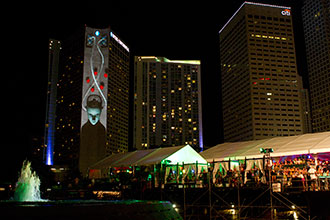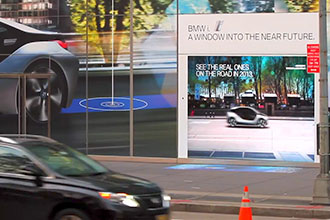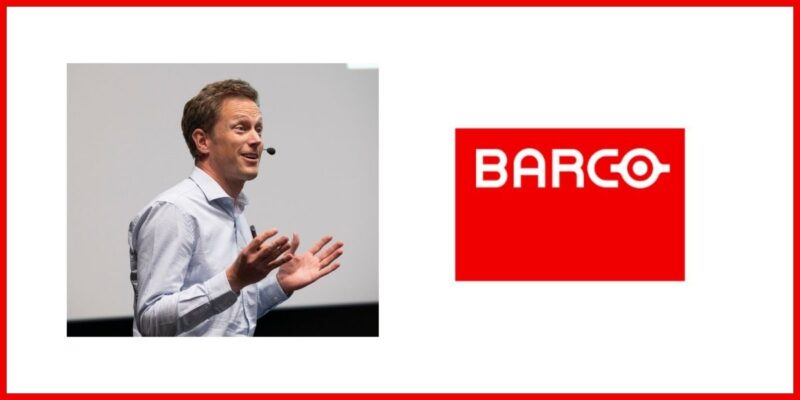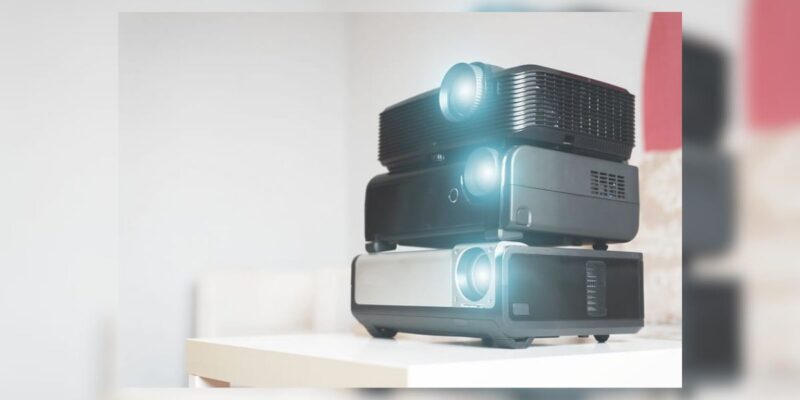The Evolution of Large-Venue Projection: Is Laser the Next Frontier?
By Richard Marples
Strategic Marketing Director, Venues & Attractions for Barco
 The entertainment world has a virtually unquenchable thirst for innovative media, embracing new technologies as soon as they’re introduced to power their creative visions. Today’s large venue projectors have evolved in technical sophistication to the point whereby visual entertainment is limited only by show producers’ imaginations. From projection mapping on mountains to virtually morphing objects on giant screens, the sky’s the limit when it comes to creating innovative entertainment venues with stunning visualization.
The entertainment world has a virtually unquenchable thirst for innovative media, embracing new technologies as soon as they’re introduced to power their creative visions. Today’s large venue projectors have evolved in technical sophistication to the point whereby visual entertainment is limited only by show producers’ imaginations. From projection mapping on mountains to virtually morphing objects on giant screens, the sky’s the limit when it comes to creating innovative entertainment venues with stunning visualization.
One of the hot, new trends is laser illumination — but there are several other aspects to consider based on new and emerging technologies. So, let’s take a closer look at where projection technologies are heading and how you can make the most of them to optimize your live events.
Projector illumination: two roads diverged
Up until recently, event producers had to rely upon xenon-based lamps as the principle light source for large-venue projectors. UHP high-pressure mercury arc lamps have grown in strength with brighter and brighter versions introduced seemingly every year. We now have single 450W UHP lamps producing around 5,500 lumens on a single chip DLP projector at a cost that we could only have dreamed of a few years ago. These advances are only expected to continue as lamp manufacturers continue to push the envelope.
Solid state lighting solutions came to the forefront a couple of years ago in the form of LED-based products. Although they have proven to be an extremely reliable light source, they have never really delivered on the brightness front. They are used more often in rear projection cubes where light output requirements aren’t that high compared to event projection levels, and where very long life time, low power consumption and good color performance are much appreciated. I don’t think we are going to see LED break into the large venue projection market in the foreseeable future.
One of the most exciting new developments in projector illumination has to do with variable, or “FLEX” lumens option as Barco calls it, with regard to our latest large-venue models. This innovative feature enables rental and staging houses to lock the brightness of a projector at a desired level so they can inventory a single model to deliver many brightness variants. As a result, they can better control the costs to maintain a fleet of projectors while maximizing lamp lifetime and keeping expenses to a minimum.
The laser equation
 What we are starting to see are hybrid laser projectors that use different combinations of Laser, Laser Phosphor and LED. This market is very much in its infancy due to a number of reasons. First, legislation in much of the developed world prohibits the use of lasers inside projectors above a certain power because of some outdated laws still on the books that were created to protect audiences in laser light shows in the ’70s and ’80s. Although a laser-powered projector is no more dangerous than a lamp-powered projector, the law will need to change before we see lasers being used properly.
What we are starting to see are hybrid laser projectors that use different combinations of Laser, Laser Phosphor and LED. This market is very much in its infancy due to a number of reasons. First, legislation in much of the developed world prohibits the use of lasers inside projectors above a certain power because of some outdated laws still on the books that were created to protect audiences in laser light shows in the ’70s and ’80s. Although a laser-powered projector is no more dangerous than a lamp-powered projector, the law will need to change before we see lasers being used properly.
Secondly, the prices of the actual lasers are still very high compared to traditional lamp costs. It is virtually impossible today to make the business case for direct laser-powered projectors versus lamps, which is why we are now seeing a path toward laser phosphor route being taken. Laser phosphor basically makes use of the cheaper blue lasers in combination with a phosphor wheel to produce red and green. We see projectors on the market now that touch about 3,000 to 4,000 lumens with promises of 20,000 hours of lifetime or so.
Based on the customers that I speak to, there seems to be some skepticism about whether these projectors will deliver the goods. Consumers should carefully read the fine print of the warranty to verify what’s included and what’s not. Even if the lasers do last the stated duration, they aren’t much good if the phosphor wheel has failed. Another question to ask is what light output can you expect to get towards the back-end of the lifetime? The laser phosphor route is however a good technology that allows for especially single chip DLP projectors to be produced at a reasonable cost probably up to about 10,000 lumens eventually.
Barco has demonstrated direct laser projectors delivering 55,000+ lumens and we still offer the brightest digital cinema projector in the world using a traditional xenon lamp. Our current brightest Xenon-based Rental & Staging projector delivers 40,000 lumens, and we have clients that regularly double stack them for shows and installations. So it is obvious that the appetite for brightness is certainly there! I’m sure you’ll see many manufacturers, including us, pushing up brightness as soon as legislation and laser pricing allows us to do so, both in single-chip and three-chip projectors, as well as in direct laser and laser phosphor configurations.
Resolution on the rise
Higher resolution is beginning to play a bigger role in large venue projection. Many show producers want to play back content in its original format, so 4K projectors are a necessity. We also see a trend for more and more resolution to support the very data rich content sets that customers are using in fixed installation projects. PC graphics cards are now capable of such high resolutions that customers want display devices to be able to view the content that they generate. Unfortunately, DLP chips are currently limited to 4K resolution and we don’t see alternative technologies gaining momentum in Large Venue because of the brightness required to push through the system.
However, in the collaboration space, we do expect to see more and more multi-channel blended screens that are capable of higher resolutions. projectiondesign, recently acquired by Barco, is the only company to date to offer a single-chip WQXGA (2560×1600) model as well as a unique Panorama projector with 21:9 2560×1080 resolution. These projectors can deliver a greatly enhanced user experience to boost the efficiency of meetings when used on a large screen in a collaborative work environment with multi-windows, data sheets, video conferencing and more. The image quality that projectiondesign projectors manage from just a single chip, a technology traditionally associated with much less expensive images, is of a very high quality.
Image processing matters
With the increasing demand for higher and higher resolution, there is a corresponding need for more powerful image processing, i.e., the processor has to be able to process many more pixels, and quickly, because frame rates are on the up as well to allow projection of 3D images. Ultra-fast switching and perfect scaling of multi-format images and sources can be accomplished with presentation switchers produced by leading manufacturers.
Blending technology is another area that has improved in general with an increasing number of manufacturers recognizing the need to perform black level compensation, in other words, adjust the black levels so that the blended region does not look so bright on dark scenes.
Another arena ripe for positive changes with respect to large venue is the delivery system. Customers should consider systems like BarcoLink, which can deliver images to projectors faultlessly and cheaply via a proprietary link that uses a single coax cable with BNC connectors to deliver 1920×1200 images at up to 60Hz over 100m. While it is possible to use systems such as HD-BaseT and other data-cabled solutions, they may not be robust enough for large venue rental and staging needs.
The price of being green
Many of the technological advancements in projector illumination, including LED, Laser and Laser/Phosphor, will make projectors more energy efficient. Using better quality optics is another way to increase efficiency, and manufacturers are working to develop more efficient prisms and light pipes that result in fewer light losses. But these are only viable in projectors that require very big amounts of light output.
However, the vast majority of customers, in my experience, are less concerned about the energy efficiency of the projector and much more focused on the initial purchase price. They would also rather have a brighter projector than one that consumes less energy. I believe this is for a number of reasons, but the main one I see is that you have two different departments involved. On the one hand, you have a purchasing department, which is typically rewarded by bringing down company expenditures on capital goods. However, these individuals have little to do with running those projectors once they are installed, so aren’t concerned with factoring in operating costs.
The fact is that until governments establish legislation that forces everyone to be greener, consumers will largely continue to maintain their current priorities. Once everyone, meaning competitors, are all being forced to comply with stricter environmental standards, companies will get on the bandwagon to employ a solution that’s green and also meets their light output and cost requirements.
By keeping all of these factors in mind when considering large venue projectors, rental and staging companies and show producers can stay abreast of new technologies and build an effective arsenal to meet their show needs now, and in the future.





